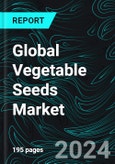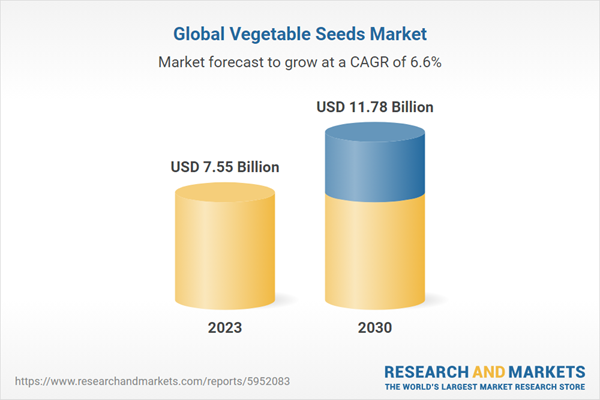Vegetable Seeds Market is anticipated to expand at a CAGR of 6.56% during the projection period (2024 to 2030)
The growing health focus drives the demand for diverse options, propelling the vegetable seeds market. As healthful eating tendencies gain momentum, customers prioritize nutritional benefits, fueling interest in numerous veggies. This surge prompts a desire for various seeds, such as heirlooms and particular types. Unique seeds promising fitness benefits or wonderful flavors are prominent by both home and industrial growers. Producers reply with improvements, enhancing crop nutrition and taste. This trend fuels market diversity, meeting evolving purchaser options. Healthy consumption catalyzes innovation, fostering a vibrant vegetable seeds market tailored to health-conscious people.Besides, seed technology innovations, including hybridization and genetically modified seeds, force growth in the vegetable seeds market. Genetically modified seeds enhance crop yields and cultivate advanced variants, decreasing greenhouse gas emissions. Despite constraints like diminishing arable land and the need for better production, genetically modified technology remains crucial for attaining sturdy yields in vegetable seeds. These advancements function as effective alternatives to chemical remedies, contributing considerably to the global vegetable seeds market's increased trajectory. So, the Vegetable Seeds Market was priced at US$ 7.55 Billion in 2023.
Also, global trade and export possibilities drive demand in the vegetable seed market by facilitating the exchange of diverse seed varieties tailor-made to exclusive climates and growing conditions. Exporting nations prioritize innovation, specializing in sickness resistance, high yield, and environmental adaptability. International exchange also promotes the adoption of advanced agricultural technology and practices, influencing the uptake of present-day seed varieties. Seed manufacturers spend money on research and development to satisfy the particular needs of various areas, fostering economic boom and enhancing agricultural productivity internationally. This global interdependence underscores the vegetable seeds market's evolution towards cutting-edge seed technology, benefiting exporting nations and agriculture globally.
Vegetable seed sales in Asia Pacific's rising economies are poised for a quick increase. This is because of a flourishing agriculture sector, rising attention about the advantages of vegetable consumption, and a booming population driving elevated production needs. The surging demand for organic foods has considerably raised vegetable consumption in international locations like India and China, mainly due to improved vegetable seed planting. This trend offers excellent opportunities for vegetable seed industry players in the foreseeable future.
Open-pollinated varieties are expected to dominate a significant share of the vegetable seeds market
Due to their acceptable developments, open-pollinated varieties are predicted to hold an extensive proportion of the global vegetable seeds market. These seeds offer genetic diversity, adaptability, and the ability to breed true to type. They cater to the growing demand for sustainable agriculture and organic farming practices, aligning with customer options for natural and non-genetically modified produce. Also, open-pollinated varieties empower farmers by letting them store seeds for future plantings, decreasing dependency on seed providers.Solanaceae may have a noteworthy portion of the worldwide vegetable seeds market
Solanaceae might command a substantial share of the global vegetable seeds market. This is because of the financial importance and recognition of its member crops. The Solanaceae plant families consist of widely eaten vegetables such as tomatoes, peppers, and eggplants, which experience a high demand globally. Solanaceae crops' versatility and diverse applications in diverse cuisines contribute to their prominence, making them key players in the vegetable seeds market. The adaptability of Solanaceae species to distinct climates also solidifies their widespread vegetable seeds market proportion.The vegetable seeds market relies heavily on open-field cultivation
Open-field cultivation represents a crucial portion of the vegetable seeds market due to its extensive adoption and versatility. This conventional farming approach permits huge-scale manufacturing across numerous climates and regions, accommodating a couple of vegetable crops. Open-field cultivation is desired for its cost-effectiveness, simplicity, and capability to provide high yields. Furthermore, it offers flexibility in crop rotation and control practices, making it a favored preference for many farmers and contributing to its tremendous share in the vegetable seeds market.China could become a prominent player in the global market for vegetable seeds
China is poised to dominate the global vegetable seeds market. Its well-sized agricultural landscape and favorable climatic conditions allow for the considerable cultivation of numerous vegetable crops. China's huge population and growing urbanization also force tremendous vegetable demand, necessitating full-size seed production. The country's solid studies and development efforts in agriculture bolster its function, creating super, high-yielding seed types. Moreover, China's sturdy production skills and aggressive pricing contribute to its ability to cater to domestic and worldwide markets, solidifying its capability to display the lion's percentage in the vegetable seeds market.Key Players
The vegetable seeds market comprises enterprises like BASF A.G., Syngenta AG, GroupeLimagrain, Bayer AG, Sakata Seed Corporation, UPL Lmt., Gansu Dunhuang Seed Co., Ltd., and JK Agri Genetics Ltd.- In July 2023 - Takii Seeds launched a new type of winter carrot called Fuyu Chiaki. These carrots have been specifically designed to adapt well to winter conditions and show good resistance to cold weather. Furthermore, they can grow well in various soils, making them a versatile choice for farmers.
Type - Vegetable Seeds Market breakup in 2 viewpoints:
1. Open Pollinated Varities2. Hybrid
Crop Type - Vegetable Seeds Market breakup in 6 viewpoints:
1. Solanaceae2. Root & Bulb
3. Cucurbut
4. Brassica
5. Leafy
6. Others
Cultivation Method - Vegetable Seeds Market breakup in 2 viewpoints:
1. Protected2. Open Field
Country - Vegetable Seeds Market breakup of 25 Countries:
1. North America1.1 United States
1.2 Canada
2. Europe
2.1 France
2.2 Germany
2.3 Italy
2.4 Spain
2.5 United Kingdom
2.6 Belgium
2.7 Netherland
2.8 Turkey
3. Asia Pacific
3.1 China
3.2 Japan
3.3 India
3.4 South Korea
3.5 Thailand
3.6 Malaysia
3.7 Indonesia
3.8 Australia
3.9 New Zealand
4. Latin America
4.1 Brazil
4.2 Mexico
4.3 Argentina
5. Middle East & Africa
5.1 Saudi Arabia
5.2 UAE
5.3 South Africa
All the key players have been covered from 3 viewpoints:
- Overview
- Recent Development
- Revenue Analysis
Company Analysis:
1. BASF A.G.2. Syngenta AG
3. GroupeLimagrain
4. Bayer AG
5. Sakata Seed Corporation
6. UPL Lmt.
7. Gansu Dunhuang Seed Co., Ltd.
8. JK Agri Genetics Ltd.
Table of Contents
Companies Mentioned
- BASF A.G.
- Syngenta AG
- Groupe Limagrain
- Bayer AG
- Sakata Seeds Corporation
- UPL Lmt.
- Gansu Dunhuang Seeds Co., Ltd.
- JK Agri Genetics Ltd.
Methodology
In this report, for analyzing the future trends for the studied market during the forecast period, the publisher has incorporated rigorous statistical and econometric methods, further scrutinized by secondary, primary sources and by in-house experts, supported through their extensive data intelligence repository. The market is studied holistically from both demand and supply-side perspectives. This is carried out to analyze both end-user and producer behavior patterns, in the review period, which affects price, demand and consumption trends. As the study demands to analyze the long-term nature of the market, the identification of factors influencing the market is based on the fundamentality of the study market.
Through secondary and primary researches, which largely include interviews with industry participants, reliable statistics, and regional intelligence, are identified and are transformed to quantitative data through data extraction, and further applied for inferential purposes. The publisher's in-house industry experts play an instrumental role in designing analytic tools and models, tailored to the requirements of a particular industry segment. These analytical tools and models sanitize the data & statistics and enhance the accuracy of their recommendations and advice.
Primary Research
The primary purpose of this phase is to extract qualitative information regarding the market from the key industry leaders. The primary research efforts include reaching out to participants through mail, tele-conversations, referrals, professional networks, and face-to-face interactions. The publisher also established professional corporate relations with various companies that allow us greater flexibility for reaching out to industry participants and commentators for interviews and discussions, fulfilling the following functions:
- Validates and improves the data quality and strengthens research proceeds
- Further develop the analyst team’s market understanding and expertise
- Supplies authentic information about market size, share, growth, and forecast
The researcher's primary research interview and discussion panels are typically composed of the most experienced industry members. These participants include, however, are not limited to:
- Chief executives and VPs of leading corporations specific to the industry
- Product and sales managers or country heads; channel partners and top level distributors; banking, investment, and valuation experts
- Key opinion leaders (KOLs)
Secondary Research
The publisher refers to a broad array of industry sources for their secondary research, which typically includes, however, is not limited to:
- Company SEC filings, annual reports, company websites, broker & financial reports, and investor presentations for competitive scenario and shape of the industry
- Patent and regulatory databases for understanding of technical & legal developments
- Scientific and technical writings for product information and related preemptions
- Regional government and statistical databases for macro analysis
- Authentic new articles, webcasts, and other related releases for market evaluation
- Internal and external proprietary databases, key market indicators, and relevant press releases for market estimates and forecasts

LOADING...
Table Information
| Report Attribute | Details |
|---|---|
| No. of Pages | 195 |
| Published | April 2024 |
| Forecast Period | 2023 - 2030 |
| Estimated Market Value ( USD | $ 7.55 Billion |
| Forecasted Market Value ( USD | $ 11.78 Billion |
| Compound Annual Growth Rate | 6.5% |
| Regions Covered | Global |
| No. of Companies Mentioned | 8 |









